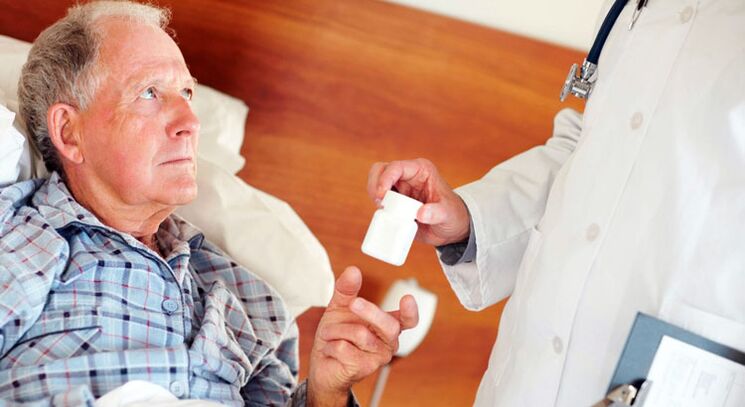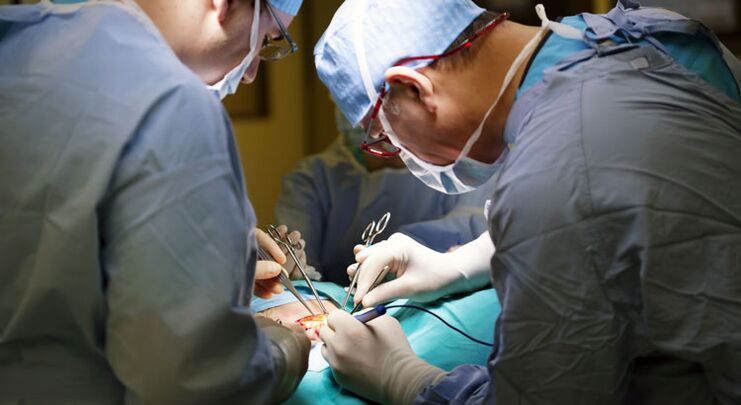
Due to the long and problematic course of therapy, and the high probability of recurrence, there is reasonable doubt as to whether chronic prostatitis can be cured. There is no clear answer to this question.
The disease detected in the early stages is completely cured in 90% of cases, but as pathological irreversible changes develop, the prognosis of treatment becomes worse. In advanced prostatitis, a stable remission can be achieved.
Which treatment is used - outpatient or inpatient?
The treatment algorithm for chronic prostatitis includes the appointment of physiotherapy and the constant use of drugs for 2-3 months. Inpatient treatment is prescribed for the following indications:
- Acute form of the disease, which is manifested by a high temperature above 38°.
- The appearance of complications due to a serious illness.
- Lack of home therapy results.
If the disease becomes latent, the patient is usually discharged from the hospital, and further treatment takes place on an outpatient basis. Advantage of hospitalization:
- Constant monitoring of treated staff.
- The possibility of providing emergency aid and pain relief.
- There is no temptation to break the recommendations regarding diet and bad habits.
- The course of therapy is constantly adjusted depending on its effectiveness.
Hospitalization has several disadvantages: the high cost of treatment (in paid clinics), the stress experienced by a person who finds himself in a hospital environment.
The outpatient clinic allows the patient to not be separated from his usual environment, engage in daily activities and do work (of course, without leaving home). Another advantage of home therapy is that it is relatively inexpensive.
The decision on how the therapy will be carried out depends on the attending physician. Based on individual indications, you can start the therapy at home. In this case, the patient should be given a detailed step-by-step treatment, which indicates the need for regular visits to the doctor and undergoing physical procedures.
How long does it take to treat chronic prostatitis?
The duration of treatment is individual. Some patients get rid of the disease in a few months, others have to be treated for years.
Several factors affect the speed of recovery:
- Stage of disease— chronic prostatitis in the early stages of development is often discovered accidentally, during the annual examination of the patient. In this phase, serious pathological changes occur in the body that require long-term therapy.
- The role of the patient- desire for better, careful adherence to treatment advice, giving up bad habits (smoking and alcohol), shortening the duration of therapy and improving its prognosis.
- Individual characteristics- statistics show that 80-90% of patients who were helped in the early stages of a chronic disease managed to completely get rid of the disease. After the transition from latent to acute form, with pronounced symptoms, the percentage of successful therapy sharply decreases to 65-70%.
The longer you wait to consult a doctor, the greater the probability that conventional complex treatment will not have the desired effect and that surgical intervention will be required.
Chronic prostatitis in some forms can develop into prostate cancer. Early diagnosis and proper treatment are a necessary condition for cancer prevention.
Is a complete cure possible?
You can completely get rid of prostatitis in the early stages of the disease. If the inflammatory process has become acute, characteristic irreversible changes in the vas deferens and tissue structure are usually observed.
When clinical symptoms appear, it becomes impossible to completely cure chronic inflammation of the prostate. Therapy is aimed at achieving stable remission.
After alleviation of acute inflammation, preventive measures are prescribed. If drug therapy fails, partial or complete surgical removal of the prostate is performed.
During the years of research, general international recommendations for the treatment of chronic prostatitis were developed, which significantly increased the recovery rate of patients. The probability of complete cure is in the range of 50-65%, achieving a stable remission is 65-80%, depending on the severity of the disease.
Methods of treatment of chronic inflammation of the prostate
Many articles on the Internet and medical reference books are devoted to how to treat chronic prostatitis. Most sources agree that there is no single effective drug to combat the disease; complex therapy is required, including:
- Drug course.
- Treatment without drugs.
- Physiotherapy.
- Operation.
- Massage.
Clinically proven chronic prostatitis treatment regimen is aimed at overcoming several negative manifestations of the disease:
- Removal of the inflammatory process.
- Removal of congestion and normalization of blood circulation in the pelvic organs.
- Elimination of the catalyst of the inflammatory process.
- Fighting the consequences of prostatitis.
- Prevention of disease recurrence.
Complex treatment of chronic prostatitis is aimed at overcoming all the mentioned negative manifestations, and is therefore more effective than monotherapy. The effectiveness of the approach largely depends on the patient's desire for recovery, which is manifested in careful compliance with all the doctor's recommendations. Another factor that contributes to the complete healing of the patient is contacting large clinics. Medical centers use modern methods of effective treatment of chronic inflammation of the prostate, which are carried out under the guidance of experienced medical staff.
The modern standard for suppressing the inflammatory process is pathogenetic therapy. The essence of the principle is to develop an individual course depending on the characteristics of the patient.
How to treat with drugs
After the diagnosis of chronic prostatitis, a man will have to be patient, because the treatment regimen involves taking medication for a long period of time. Success in the fight against the disease depends on careful adherence to the prescribed schedule of therapy.
The duration of treatment of chronic prostatitis ranges from several months to six months. It is forbidden to stop taking the medication on your own when you feel better, as this can cause a stable form of the disease.
Standard treatment includes prescribing the following drugs:
- Antispasmodics and analgesics— from the beginning and almost to the end of treatment, the disease is accompanied by severe pain associated with swelling of the gland. If symptoms cannot be alleviated, additional anesthetic injections are recommended.
- Anti-inflammatory drugs— suppositories containing a substance from the group of phenylacetic acid derivatives are recommended. The use of rectal suppositories is effective due to the almost direct action of the active components on the prostate tissue.
The phenylacetic acid derivative is absorbed into the blood through the rectum and quickly relieves the symptoms associated with the disease. Anti-inflammatory therapy includes the prescription of corticosteroids and NSAIDs. - Antiviral and antibacterial agents.Treatment standards prescribe the use of antibiotics in two cases. A course of therapy is necessary in the presence of an infectious catalyst factor that caused the inflammation, as well as a preventive measure before surgical treatment.
In order to increase the effectiveness of drugs, lymphotropic therapy is carried out. Antibiotics are injected into the lymph nodes, which blocks venous outflow and drains the bladder. Instillation (direct injection of antibiotics into the bladder) is performed.

In the later stages of the disease, a conservative method of treatment is used. Regular use of drugs (alpha blockers and NSAIDs) is necessary to reduce the rate of prostate growth and reduce unpleasant symptoms. In parallel with drug therapy, non-drug and physical therapy is carried out.
Therapy without drugs
Advanced world experience convincingly proves the effectiveness of an integrated approach to the treatment of chronic prostatitis. At the same time as taking medication, the patient is prescribed new methods of non-drug therapy. Among them:
- Microwave hyperthermia- prostate tissue is exposed to high temperatures. The source of thermal energy is brought to the prostate by the transrectal method. Microwave therapy promotes a better effect of drugs and preservation of prostate growth.
- Shock wave therapy.The consequence of chronic prostatitis is the appearance of irregularities in the soft tissues of the gland. The seals were destroyed by the shock wave. The result of the procedure is the removal of the inflammatory process and improvement of blood supply.
The use of shock wave therapy in complex treatment shortens the period of hospitalization of patients and increases the efficiency of taking medication. - Laser therapy of chronic inflammation of the prostate— the effect is based on the treatment of the gland with narrowly focused rays of light. Laser treatment leads to an increase in the lumen of blood vessels, improvement of tissue metabolism and, as a result, tumor resorption. Another positive effect is accelerated regeneration of damaged tissue.
- Ultrasonic applications— intense vibrations of emitted waves cause tissue regeneration, improve trophism and metabolic processes. Ultrasound treatment devices are so easy to use that they can be purchased for home use. The device kills parasites and has a bactericidal effect.
Methods of therapy without drugs are prescribed individually, taking into account the presence of contraindications for the patient.
Physiotherapy approach
Innovative methods of chronic prostatitis treatment are often combined with time-tested methods. Physiotherapy has a beneficial effect.
The purpose of procedures has several purposes:
- Increase blood flow.
- Establish metabolic processes in the body.
- Reduce areas of inflammation.
- Accelerate lymph flow to remove pathogens from the prostate.
- Stimulate the immune system and activate your own forces to fight disease.
The physiotherapeutic approach is used in the largest medical centers around the world. In Israeli hospitals, after completing the course of therapy, sanatorium treatment on the coast of the Dead Sea is mandatory.
Rapid improvement of well-being is achieved by conducting the following physiotherapy courses:
- Phonophoresis— the technique boils down to the introduction of vitamins and drugs into the tissues of the skin and prostate under the influence of ultrasound. It has a positive effect on the body on a mechanical and chemical level, and the effect of drugs is enhanced.
- Reflexology— the term refers to the entire system of practices based on the influence on human biologically active points. Other names for the technique: acupuncture, acupuncture.
During the session, the effect on the nerve endings leads to improvement of static gland, normalization of blood circulation and reduction of pain. - Vacuum treatment (cans)— many experts agree that disturbances in the work of internal organs cause pathologies of the spinal column. The technique is effective in the fight against congestion, after 1-2 sessions the functioning of the prostate noticeably improves, and urination normalizes.
- Electrical stimulators— the procedure is effective in the treatment of any form of prostatitis, improves erection and activates the immune system. The use of electrostimulation lasts 10-15 days.
During the session, a source of electrical current is delivered to the prostate gland through the prostate gland. The waves affect the prostate, bone and muscle tissue, which stimulates their work.
Physiotherapy does not replace drug treatment during an exacerbation, but promotes the effectiveness of prescribed drugs, speeding up a man's recovery.
Surgery for chronic prostatitis
If the course of treatment of chronic prostatitis does not produce results, a stable progression of the disease is observed and surgery is prescribed. Several methods have been developed:
- Prostatectomy.
- Prostate resection.
- Laser removal.
- Laparoscopy.

The choice of surgical intervention depends on several factors: the age of the patient, the invasiveness of the method, the presence of contraindications and the volume of the prostate.
The latest technologies for performing operations are associated with the absence of the need for abdominal tissue dissection. Removal of the prostate takes place through the urethral canal or several small holes in the abdominal region.
Laser prostate removal is widely used. A high-intensity light beam vaporizes the glandular tissue, which leads to a reduction in prostate volume.
The main feature of modern surgical treatment is minimal damage to the human body, which leads to a reduction in rehabilitation time and quick recovery with complete restoration of all basic functions of the genitourinary system.
Because of the high risks in old age, after 60-65 years, surgical treatment is practically not performed. The therapy is reduced to alleviating the symptoms of prostatitis and improving the condition and quality of life.
Massage treatment
Clinical recommendations for the treatment of prostatitis boil down to the need for digital transrectal massage of the gland. During the tactile action on the tissue, the areas are massaged, which improves blood supply and relieves pain.
The main task of the massage remains to push out the glandular stone containing the inflammatory exudate.
Contraindications for prostate massage:
- Cystitis during exacerbation.
- Hemorrhoids.
- Acute prostatitis.
Treatment reviews show that the first procedures of prostate massage are quite painful, but bring great relief. Massage is performed exclusively by a specialist. It is prescribed during the recovery period after drug treatment.
Prevention of relapse of chronic prostatitis
Modern approaches to the treatment of chronic prostatitis do not consist so much in the fight against inflammation of the prostate, as in the application of effective preventive measures to prevent recurrence of the disease.
Prevention of recurrence of prostatitis includes:
- Transrectal digital massage is performed every year.
- Diet and lifestyle adjustments. General recommendation, preparing a diet similar to the Mediterranean or treatment table no. 5.
- Implementation of complex anti-relapse therapy. The course of treatment includes drugs and procedures aimed at removing congestion in the pelvic organs, as well as strengthening the immune system. Recommended sports: yoga, exercise therapy.
The anti-relapse treatment protocol includes regular doctor visits, mandatory clinical blood and urine tests, and PSA tests at least every 6 months.
A healthy lifestyle, regular sexual relations, giving up alcohol and smoking - all this prevents the return of prostatitis, has a beneficial effect on men's health and allows you to lead a rich and fulfilling life.






























